How earned media drives consumer behavior: Social media, sentiment and backlinks
Surprising findings from a study of more than 100,000 articles.

Over the last two weeks, I’ve been sharing fascinating insights about the relationship between core earned media attributes and consumer behavior, based on Onclusive’s recent study of global PR measurement data from over 100,000 articles.
Publication authority turned out to be a strong driver of consumer activity at the top of the marketing funnel -– such as pages viewed and actions taken on your brand website as a result of reading a media article. Article brand relevance, not so much.
Today, we’re looking at article brand engagement and sentiment as predictors of your website traffic and actions.
And these findings are the most surprising of all, so let’s dive in!
Social media engagement and consumer behavior
Social media engagement represents the number of likes, shares, comments, re-tweets, re-pins and other social media interactions that a media article receives on a social network.
Drum roll, please!
Of all the media characteristics we analyzed, the level of social media engagement emerged as the biggest predictor of website traffic, with highly engaged articles driving 113% more website visitors than low-engaged articles.
The correlation is even more pronounced when it comes to website actions, with highly engaged articles driving 280% more website activity than low engaged articles:
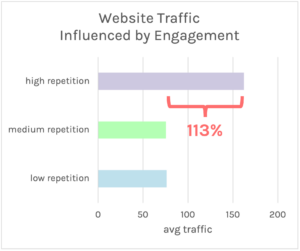
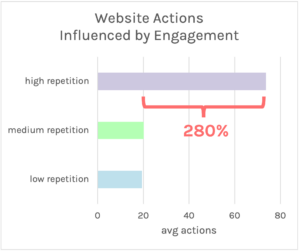
How you can use this in your PR strategy:
- To capitalize on social media engagement as an extraordinary driver of website traffic and actions, subscribe to a comprehensive media monitoring or social listening service.
- This technology allows you to consistently track which content your audience engages with the most and produce more content like that to drive desired consumer behavior.
Brand sentiment and consumer behavior
Brand sentiment is the tone and sentiment of an article towards the company or brand being mentioned. It can be positive, negative, or neutral.
In our study, this was the most unexpected finding of all.
We discovered that despite what you might expect, sentiment is negatively correlated with both website traffic and actions.
Positive sentiment articles result in 50% less traffic than negative sentiment articles, and neutral sentiment articles result in 49% less traffic than negative sentiment articles. Positive sentiment articles also drive 3% less traffic than neutral sentiment articles.
Similarly, positive sentiment articles result in 31% fewer website actions than negative sentiment articles, but positive sentiment articles do drive more (41%) website actions than neutral sentiment article
Website actions, which include not just signs up and purchases, but also pages viewed, are a strong indicator of brand awareness and interest from your audience.
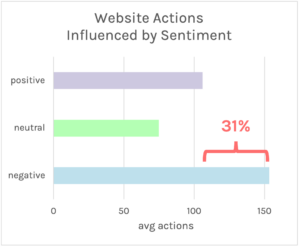
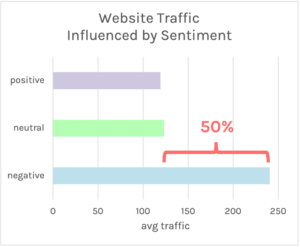
Therefore, the quality of your website content is equally important both in good times and during a crisis. However, good crisis management can also make a huge difference to the level of sentiment in articles.
How you can use this in your PR strategy:
- While the adage “all press is good press” may not necessarily be true for brand reputation, it does appear that negative media coverage drives more website activity. Conceivably, people are more interested in learning about companies with negative press than in those with positive press.
- Overall, while ensuring a consistent flow of positive content and a proactive way to distribute this content to the media, always maintain a solid crisis management plan.
- Even during a crisis, you can generate significant interest in your brand and influence consumer behavior in a positive way. Be prepared to capitalize on these events if and when they arise.
Presence of a backlink and consumer behavior
We define a “backlink” as a link to a brand’s website, embedded in a media article mentioning that brand.
This insight is not surprising. The presence of a backlink is highly correlated with website traffic, and we see traffic increase by 87% when a backlink is present in an article.
And while a backlink is less predictive of website actions performed by those website visitors, it can still drive 45% more actions:
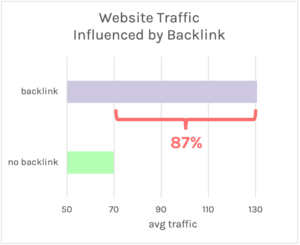
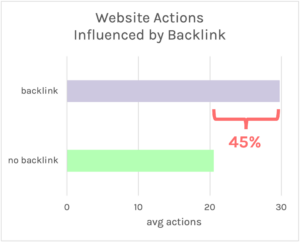
How you can use this in your PR strategy:
- The fact is, there is not much you can do to influence whether a published article about your brand includes a backlink or not.
- While the data above suggest you should certainly request it, the presence of a backlink in your earned media content remains within the author’s and publication’s control.
- That said, if your website has relevant, up-to-date and useful information, other websites (including media outlets), are more likely to link to it.
A word about our research methodology
We analyzed over 100,000 media articles published globally between January 1 and December 31, 2021, about a representative sample of business-to-consumer (B2C) and business-to-business (B2B) brands across a broad set of industries. The articles in the study included only earned media content published via digital media (excluding social media).
Zack Jenkins is US general manager for Onclusive.
For more insights, check out the rest of the articles in our ‘Earned Media Attributes That Drive Consumer Behavior’ 3-part series – Publication Authority and Consumer Behavior, and Article Brand Relevance and Consumer Behavior.






